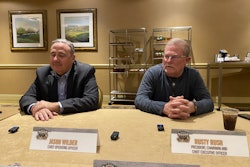The trucking industry often has had to adapt to change over the past few years, and one such area in which change has occurred is lighting.
Gradually, the industry has moved toward using light-emitting diodes (LEDs) in place of the traditional incandescent lights that were commonly used.
According to the Technology & Maintenance Council (TMC), LEDs have proven to be superior to incandescent bulbs because they offer durability and brightness, improved safety and ensure sufficient voltage is available for proper antilock braking system operation.
A single LED is a solid-state electronic component, and when current flows through the semiconductor compounds, light is emitted.
Because there is no evaporation of components, and because it is a solid state component, LED service life is significantly longer than that of incandescent bulbs, according to TMC.
An individual LED remains an effective light source for approximately 100,000 hours, or about six times that of an average incandescent light bulb.
According to Peterson Manufacturing Co., unlike traditional incandescent lights that use bulbs, LED lamps do not use delicate wire filaments that stretch, weaken and eventually fail. Therefore, LED lamps may last longer because they withstand road vibration and shock much more effectively than bulbs.
Besides offering longevity, LED lamps consume significantly less power than incandescent lights. The amp draw of an LED can be as low as one-tenth that of an incandescent light, which means more power for other critical electrical needs, according to Peterson.
Brad Van Riper, senior vice president and chief of technology, Truck-Lite Co., said that LEDs draw about 75% less current (amperage) than incandescent lamps performing the same function.
“This is a real advantage in most areas because of the power savings, with the exception of maintaining the circuit in a corrosive environment. The higher current draw actually can scrub through corrosion and maintain the circuit,” he explained.
“Corrosion in this case will become the winner as dissimilar metals in the presence of an electrical current, salt and water eventually will cause a failure.”
As with most other vehicle components, corrosion can be detrimental to the lighting system.
Mark Assenmacher, director of marketing, Peterson Manufacturing Co., said that it’s important to look at the lenses regularly to ensure they are not cracked. “A cracked LED lens is similar to a cracked television screen; it will function, but still must be replaced or repaired. Also, check for physical lamp damage from debris or rocks that may have been kicked up from the road,” he said.
Van Riper said that during a pre-trip inspection, your customer can make sure that snow and ice, for example, are removed from blocking the lighting system to achieve maximum visibility and safety.
“I would suggest that an occasional cleaning of the lenses with soapy water or detergent may be necessary if your customer has been in a particularly dirty environment,” he added.
Not only can corrosion harm the lamps, but it affects the wiring and connections as well.
Chris Cammack, brand manager, Grote Industries, said that preventive maintenance of the harness and connections is key to long lighting life.
“The technician must avoid splicing into the harness, and if he is using the male pin system, he should use his ice pick tester only at the connection point and not directly into the harness. The pin point holes would allow for water intrusion and corrosion soon after the test is complete,” he explained.
Although the light source is different between LEDs and incadescent lamps, connection problems really are the same for all lighting systems, Cammack said.
“It’s important to have enough voltage available as well as a good ground. In order to get the full benefit of the long-life light source, use a high quality dielectric grease at installation and during maintenance cycles, and be sure that all wiring is secure and not worn by abrasion or that there is too tight a radius wire channel,” he explained.
Van Riper added, “In an LED device, take care selecting the connector. Because the life of an LED lamp assembly is so much longer, the connector may become the new weak link in the system.”
He continued, “The chain is only as strong as its weakest link, so in order to get the full life expectancy from the LED technology, you need to ensure that all of the components of the wiring harness system are as robust as the LED.”
Van Riper talked about two topics he believes are influencing the use of LEDs today. “The two hot topics relative to LEDs and heavy-duty vehicles are the focus on reduced idling and the advancement of white LED technology,” he explained.
“Many OEMs are looking at ways to reduce the current loads on their vehicles as a result of the anti-idling legislation. One quick and easy way to reduce the current draw is to switch the interior lighting packages to all LED products,” he said.
“Since the amperage draw reduction can be more than 50% by switching to LED interior lighting, this is forcing many truck and trailer OEMs to take a careful look at a new interior lighting strategy,” Van Riper said.
With the continued advances in white LED performance improvements, new frontiers are being considered for the use of white LED technology. Van Riper said, “For example, my company has made available a lamp that produces comparable light output to the incandescent technology, but that is far more shock resistant and draws less current.” He predicted that white LED fog, driving and headlamps would begin to enter the marketplace before 2010.
Perhaps the number one reason why LEDs are becoming increasingly popular has to do with the safety issues these lamps provide. According to Peterson, when a vehicle’s brake lights are applied, LEDs respond instantaneously and provide a brighter, more focused illumination, whereas incandescent lights take about a quarter of a second to get to 90% of their full brightness.
Peterson’s web site cited a study by the University Of Michigan’s Transportation Research Institute, which found that LED lamps respond on an average two-tenths of a second faster than standard incandescent lamps. Test results at 65 mph showed that LEDs improved reaction time and decreased braking distance by 16′.
When the lighting system is installed properly, the technician and the driver will need to do very little to prevent future problems.
It’s important that the technician check for any buildup of debris or signs of corrosion, both on the lamp as well as within the connectors and harnesses.
Performing this quick inspection of the lamps will ensure that your customers don’t come back to your shop because of their lighting system problems.
A Challenge
When asked if are there any challenges that LEDs present that prior lighting sources did not, Brad Van Riper, senior vice president and chief of technology, Truck-Lite Co., responded, “The wide variety of uses for LED lighting can produce some challenges, and the most consistent challenge is the effect of LEDs on flasher modules.
“Because they pull such a small amount of amperage, sometimes you see a lamp out indicator even when everything is in good working order,” he said.
“This can be overcome by using an LED flasher which retrofits into the standard location and knows what to look for in terms of low amp pull.”
Van Riper added that this often occurs in day cabs and straight trucks and not typically in Class 8 vehicles. “While LEDs are certainly a different light source, the function is the same and maintenance and proper installation still is important,” he said.
For More Information
For more information on the lighting system, you may contact the following companies directly. Other companies offering information on lighting can be found in the Truck Parts & Service Aftermarket Buyers’ Guide & Directory as well as in Buyers’ Guide section on our web site at www.truckpartsandservice.com.
Federal-Mogul Corp.
Wagner Lighting
Southfield, MI
248-354-7700
www.federal-mogul.com
Grote Industries, Inc.
Madison, IN
812-273-2121
www.grote.com
Peterson Manufacturing Co.
Grandview, MO
816-765-2000
www.pmlights.com
Phillips Industries
Santa Fe Springs, CA
800-423-4512
www.phillipsind.com
Truck-Lite Co., Inc.
Falconer, NY
800-562-5012
www.truck-lite.com







